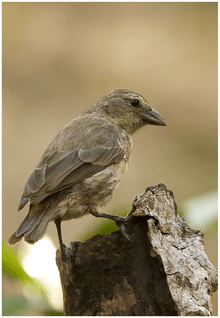Mangrove finch
The mangrove finch (Camarhynchus heliobates) is a species of bird in the Darwin's finch group of the tanager family Thraupidae. It is endemic to the Galápagos Islands. It was found on the islands of Fernandina and Isabela, but recent surveys have failed to record the species on Fernandina. It has been classified as critically endangered by BirdLife International, with an estimated population of between 60 and 140 located in two large mangroves on Isabela.[2] A study has shown that the two small populations remaining on Isabela Island have begun undergoing speciation and that one or both populations will eventually become extinct due to a lack of interbreeding.[3]
| Mangrove finch | |
|---|---|
 | |
| Scientific classification | |
| Kingdom: | Animalia |
| Phylum: | Chordata |
| Class: | Aves |
| Order: | Passeriformes |
| Family: | Thraupidae |
| Genus: | Camarhynchus |
| Species: | C. heliobates |
| Binomial name | |
| Camarhynchus heliobates (Snodgrass & Heller, 1901) | |
| Synonyms | |
|
Geospiza heliobates | |
Habitat
As its name suggests, the mangrove finch lives in the mangroves of the Galápagos Islands. The mangrove finch feeds upon the various insects, larvae, spiders, and vegetable matter found in the mangroves. It closely resembles the far commoner woodpecker finch, but is not known to utilize tools.
Predators
The main predators of the mangrove finch are cats, fire ants, paper wasps, and especially destructive black rats and parasitic flies. The black rats (Rattus rattus) are predators that account for 54% mortality rate of the mangrove finch during egg incubation, while the larvae of the parasitic fly (Philornis downsi) add an additional 14% mortality rate of newly hatched chicks.[4] Due to high predation rates in 2007 and 2008, rat poison was spread throughout different mangrove sites where the finches lived, which decreased rat predation to 30% mortality of the finch eggs. A year before the rat poison was dispersed, predation was observed in 70% of nests and the average success of nesting was 18%.[5] However, by 2013 the parasitic fly larvae Philornis downsi (introduced to the Galapagos Islands circa 1960s ) had spread and killed ~55% of Darwin’s finch nestlings within nests.[6]
Conservation
The mangrove finch is classified as Critically Endangered on the IUCN Red List, with less than 100 individuals alive today.
In January 2014, project researchers reported successfully raising 15 mangrove finch chicks in captivity and releasing them back into the wild. Since then, 36 fledglings have been 'head-started' and the project is building on this success.[7]
The Mangrove Finch Project is a bi-institutional project carried out by the Charles Darwin Foundation and Galapagos National Park in collaboration with San Diego Zoo Global and Durrell Wildlife Conservation Trust. The project is supported by the Galapagos Conservation Trust, The Mohamed bin Zayed Species Conservation Fund, Durrell Wildlife Conservation Trust, The Leona M. and Harry B. Helmsley Charitable Trust, Galapagos Conservancy, and the British Embassy in Ecuador.[8]
References
- BirdLife International (2016). "Geospiza heliobates". IUCN Red List of Threatened Species. 2016: e.T22723786A94832935. doi:10.2305/IUCN.UK.2016-3.RLTS.T22723786A94832935.en.
- "Species factsheet: Mangrove Finch". BirdLife International. 2007.
- "Darwin's rarest finch meets an 'evolutionary dead end'". Ars Technica. 27 June 2010.
- Fessl, B, & Young, G (2010). How to save the Rarest Darwin's Finch from Extinction: The Mangrove Finch on Isabela Island. Philosophical Transactions of the Royal Society B: Biological Sciences, 365, 104
- Bergstrom, C, & Dugatkin, L (2012). Parasite Infestation and Predation in Darwin's Small Ground Finch: Contrasting Two Elevational Habitats between Islands. Journal of Tropical Ecology, 26, 285.
- Kleindorfer, Sonia; Dudaniec, Rachael Y. (2016-08-23). "Host-parasite ecology, behavior and genetics: a review of the introduced fly parasite Philornis downsi and its Darwin's finch hosts". BMC Zoology. 1 (1): 1. doi:10.1186/s40850-016-0003-9. ISSN 2056-3132.
- "Mangrove finch chicks born in captivity successfully released". Galapagos Conservancy, Inc. Retrieved 2020-07-06.
- "Saving the mangrove finch". Galapagos Conservation Trust. Retrieved 2020-07-06.
